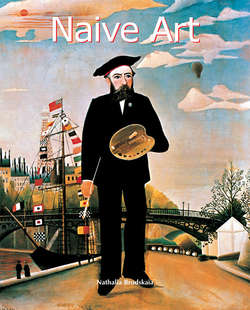Naive Art

Реклама. ООО «ЛитРес», ИНН: 7719571260.
Оглавление
Nathalia Brodskaya. Naive Art
I. Birth of Naive Art
When Was Naive Art Born?
Modern Art in Quest of New Material
Discovery – the Banquet in Rousseau’s Honour
II. Back to the Sources: From the Primitives to Modern Art
Primitive Art and Modern Art: Miró’s Case
From Medieval to Naive Artists: A Similar Approach?
Naive Art Sources: From Popular Tradition to Photography
Naive Artists and Folk Art
Naive Artists and Photography
III. Discoveries in the East
Pirosmani’s Case
Naive Painting in Romania
Conclusion: Is Naive Art Really Naive?
Major Artists
France Henri Rousseau, also called the Douanier Rousseau (Laval, 1844 – Paris, 1910)
Louis Vivin (Hadol, 1861 – Paris, 1936)
Jean Eve (Somain, 1900 – Louveciennes, 1968)
Séraphine Louis, also called Séraphine de Senlis (Arsy, 1864 – Clermont, 1942)
Dominique Peyronnet (1872–1943)
André Bauchant (Château-Renault, 1873 – Montoire, 1958)
René Martin Rimbert (1896–1991)
Camille Bombois (Vénaray-lès-Laumes, 1883 – Paris, 1970)
Aristide Caillaud (Moulins, 1902 – Jaunay-Clan, 1990)
Spain Joan Miró (Joan Miró i Ferra) (Barcelona, 1893 – Palma de Mallorca, 1983)
Miguel Garcia Vivancos (Mazarrón, 1895 – Cordova, 1972)
Italy Orneore Metelli (Terni, 1872 – Terni, 1938)
Guido Vedovato (Vicenza, 1961 —)
United States Edward Hicks (Langhorne, 1780 – Newtown, 1849)
Morris Hirshfield (1872–1946)
Anna Mary Robertson, also called Grandma Moses (Greenwich, 1860 – Hoosick Falls, 1961)
Georgia Niko Pirosmani (Pirosmanashvili) (Kakheti, 1862 – Tiflis (today Tbilisi), 1918)
Poland Nikifor Krylov (Krynica Wiés, 1895–1968)
Croatia Ivan Generalic (Hlebine, 1914 – Koprivnica, 1992)
Serbia Milan Rašic (Donje Stiplje, 1931 —)
Israel Shalom Moscovitz, also called Shalom of Safed (Safed, 1887–1980)
Отрывок из книги
Henri Rousseau, also called the Douanier Rousseau, The Charm, 1909.
Oil on canvas, 45.5 × 37.5 cm.
.....
The problems begin even in finding a proper name for this kind of art. No single term is descriptive enough. It is all very well consulting dictionaries – they are not much use in this situation. A dictionary definition of a ‘primitive’ in relation to art, for example, might be “An artist or sculptor of the period before the Renaissance”. This definition is actually not unusual in dictionaries today – but it was first written in the nineteenth century and is now badly out of date because the concept of ‘primitive’ art has expanded to include the art of non-European cultures in addition to the art of naive artists worldwide. In incorporating such a massive diversity of elements, the term has thus taken on a broadness that renders it, as a definition, all too indefinite. The description ‘primitive’ is simply no longer precise enough to apply to the works of untaught artists.
The word ‘naive’, which implies naturalness, innocence, unaffectedness, inexperience, trustfulness, artlessness and ingenuousness, has the kind of descriptively emotive ring to it that clearly reflects the spirit of such artists. But as a technical term it is open to confusion. Like Louis Aragon, we could say that “It is naive to consider this painting naive.”[1]
.....